Closed Exhibition - Queen Elizabeth II by Cecil Beaton: A Diamond Jubilee Celebration
Cecil Beaton: about the Exhibition
8 February - 22 April 2012
The photographs of the British royal family by Sir Cecil Beaton (1904-1980) were central to shaping the monarchy's public image in the mid-20th century. Her Majesty Queen Elizabeth II was still a young princess when she first sat for Beaton in 1942. Over the next three decades he would be invited to photograph the Queen on many significant occasions, including her Coronation Day in 1953.
The most memorable of Beaton's images combine the splendour of historic royal portrait painting with an intimacy that only photography and film can convey. His detailed diary accounts reveal the complexities of each sitting, from the intense planning and excitement beforehand to the pressures of achieving the perfect shot.
Beaton bequeathed his archive of royal portraits to his devoted secretary Eileen Hose. In 1987 she, in turn, bequeathed the archive to the V&A. Photographs, diaries, personal letters and press cuttings combine to tell the fascinating story of a magnificent collaboration between crown and camera.
A premier portrait photographer
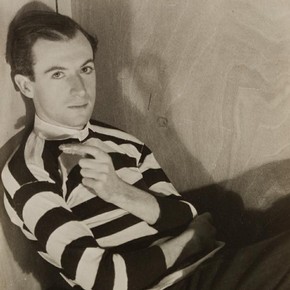
Cecil Beaton by Curtis Moffat, Gelatin silver print, about 1930. Museum no. E.1557-2007, © Victoria and Albert Museum, London/Estate of Curtis Moffa
Cecil Beaton began to pursue photography at a very early age. As a teenager he spent many hours attempting to recreate the look of glamorous society portraits using his sisters, Nancy and Baba, as models.
His career took off in the mid 1920s, when he began to contribute photographs and illustrations to Vogue magazine. His first solo exhibition in London in 1927 established him as one of the leading fashion photographers and portraitists of his generation.
Beaton became sought-after on both sides of the Atlantic, photographing famous faces from Hollywood, the theatre world and society. From the 1950s his set designs for theatre and films, such as My Fair Lady (1956), defined the glamorous look of the era. Candid snapshots and studio portraits of Beaton by his contemporaries display his sense of style, his charm, vanity and vivacious personality.
Princess Elizabeth and the portrait tradition
'The telephone rang. 'This is the lady-in-waiting speaking. The Queen wants to know if you will photograph her tomorrow afternoon' ... In choosing me to take her photographs, the Queen made a daring innovation. It is inconceivable that her predecessor would have summoned me - my work was still considered revolutionary and unconventional.'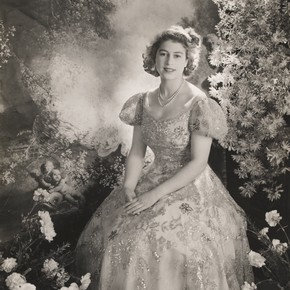
Princess Elizabeth by Cecil Beaton, Gelatin silver print, Buckingham Palace, March 1945. Museum no. E.1361-2010, © Victoria and Albert Museum, London
Cecil Beaton's diary, July 1939
The opportunity to photograph Queen Elizabeth, Queen Consort of King George VI, was the high point of Beaton's career to date. Published two months after the outbreak of the Second World War, his images presented a sense of continuity with a magnificent pre-war Britain. Several wartime sittings of the Queen and her family would reinforce his vision of a seemingly unshakable monarchy and witness the transformation of her daughter Princess Elizabeth from girl to young woman.
The flowers that appear in many of Beaton's portraits were often picked from his own garden. Cascading arrangements of roses, carnations, lilies and hydrangeas filled the space between a photographic backdrop and the sitter, and were an essential prop in the creation of his idealised Arcadian scenes.
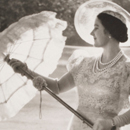
Cecil Beaton, Queen Elizabeth in Buckingham Palace Garden
Queen Elizabeth, Buckingham Palace Garden
Cecil Beaton
1939
Gelatin silver print
Museum no. E.1374-2010
© Victoria and Albert Museum, LondonBeaton struck up an instant rapport with the Queen. His diary reveals that she was an active participant in the staging of her romantic portraits, suggesting suitable dresses and accessories. Here, Beaton combined a painterly eye with the elegant style of his Vogue fashion studies. Like those, each royal portrait would be carefully retouched under Beaton's instruction, to define facial features and trim silhouettes.
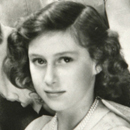
Cecil Beaton, Queen Elizabeth, Princess Elizabeth & Princess Margaret
Queen Elizabeth, Princess Elizabeth and Princess Margaret
Cecil Beaton
Buckingham Palace
October 1942
Gelatin Silver Print
Museum no. Ph.677-1987
© Victoria and Albert Museum, LondonThis study of the family in simple dress was taken when Beaton was invited to photograph the visit of Mrs Franklin Roosevelt, the First Lady of the United States, to Buckingham Palace. It was perhaps intended to show the ordinariness of royalty, who, like other Britons, experienced food rationing during the war.
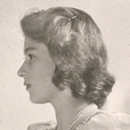
Cecil Beaton, Princess Elizabeth
Princess Elizabeth, Buckingham Palace
Cecil Beaton
October 1942
Gelatin silver print
Museum no. Ph.289-1987
© Victoria and Albert Museum, LondonBeaton found the 1942 sitting a challenging one. He wrote in his diary of his quest for originality and his desire to produce a 'composition that is not merely a pastiche of the past'. The sixteen year-old Princess Elizabeth posed in the Bow Room at Buckingham Palace, beside Winterhalter's portrait of Prince Leopold at the age of three months.
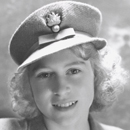
Cecil Beaton, Princess Elizabeth as Colonel of the Grenadier Guards
Princess Elizabeth as Colonel of the Grenadier Guards, Buckingham Palace
Cecil Beaton
October 1942
Gelatin silver print
Museum no. Ph.220-1987
© Victoria and Albert Museum, LondonIn February 1942, the King appointed his fifteen-year-old daughter Colonel of the Grenadier Guards, the senior Regiment of the Foot Guards. It was the first time in history that a woman had held the position. The Princess wears an embroidered grenade in her cap and a blue enamelled and diamond brooch, the Regimental cypher, presented to her by the Regiment on her sixteenth birthday.
The Coronation
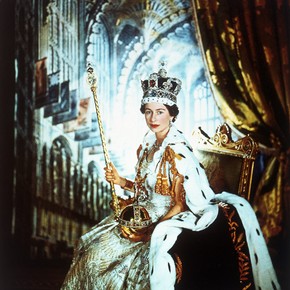
Queen Elizabeth II by Cecil Beaton, 2 June 1953. Museum no. PH.311-1987, © Victoria and Albert Museum, London
On the morning of 2 June 1953, three million people lined the streets between Buckingham Palace and Westminster Abbey to witness the process of the Gold State Coach. Millions more crowded around newly bought television sets to watch the investiture of Britain's youngest sovereign since Queen Victoria. For many, the Coronation represented the beginning of a new age. It was a time for optimism and innovation that the press termed 'the new Elizabethan era'.
Cecil Beaton attended the ceremony, along with 8,000 other guests. He sat in a balcony close to the pipes of the great organ, recording his impression of the glorious pageant in animated prose and black ink sketches. After the ceremony he returned to the Palace to make final preparations for the official portrait sitting.
In this glittering portrait, the Queen wears the imperial state crown, a replica of that made for Queen Victoria's Coronation. The Queen holds the sceptre with the cross in her right hand, balanced by the orb in her left. On her right hand she wears the coronation ring, a symbol that the sovereign is 'wedded' to the state. On both wrists are the armills, golden bracelets signifying sincerity and wisdom.
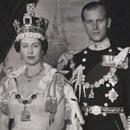
Cecil Beaton, The Coronation - Queen Elizabeth II & Prince Philip, Duke of Edinburgh
Queen Elizabeth II and Prince Philip, Duke of Edinburgh
Cecil Beaton
Gelatin silver print
2 June 1953
Museum no. PH.1551-1987
© Victoria and Albert Museum, LondonThe Coronation portraits were widely published and the Queen sent out numerous presentation prints as official gifts. Copies of this full-length portrait were given to the royal family and members of Prince Philip's family. The Queen's Coronation gown was designed by couturier Norman Hartnell and exquisitely embroidered with the floral emblems of the countries of the Commonwealth.
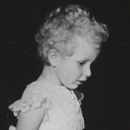
Cecil Beaton, The Coronation - Princess Anne
Princess Anne
Cecil Beaton
Gelatin silver print
2 June 1953
Museum no. PH.324-1987
© Victoria and Albert Museum, LondonThe Queen's young children were full of energy throughout the afternoon. The serenity of the Queen Mother calmed the apprehensive photographer. 'All at once, and because of her, I was enjoying my work. Prince Charles and Princess Anne were buzzing about in the wildest excitement and would not keep still for a moment. The Queen Mother anchored them in her arms, put her head down to kiss Prince Charles' hair, and made a terrific picture.'
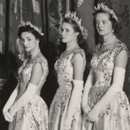
Cecil Beaton, The Coronation - Queen Elizabeth II with her Maids of Honour
Queen Elizabeth II with her Maids of Honour
Cecil Beaton
Gelatin silver print
2 June 1953
Museum no. PH.1530-1987
© Victoria and Albert Museum, LondonIn selecting six Maids of Honour instead of pages to bear her velvet train throughout the Coronation ceremony, the Queen followed the precedent of Queen Victoria. From left to right, they were:
Lady Moyra Hamilton (now Lady Moyra Campbell), Lady Anne Coke (now The Rt Hon The Lady Glenconner), Lady Rosemary Spencer-Churchill (now Lady Rosemary Muir), Lady Mary Baillie-Hamilton (now Lady Mary Russell), Lady Jane Heathcote-Drummond-Willoughby (now The Rt Hon The Baroness Willoughby de Eresby), Lady Jane Vane-Tempest-Stewart (now The Rt Hon The Lady Rayne)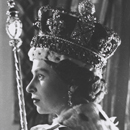
Cecil Beaton, The Coronation - Queen Elizabeth II
Queen Elizabeth II
Cecil Beaton
Gelatin silver print
2 June 1953
Museum no. PH.1540-1987
© Victoria and Albert Museum, LondonThis portrait echoes the centuries-old tradition of depicting rulers in profile on coins and medals. Dramatic lighting highlights the Queen's youthful features. The prime minister, Winston Churchill, voiced the feelings of many when he described her as a metaphorical guardian angel: 'The gleaming figure whom Providence has brought to us in times when the present is hard and the future veiled.'
The next generation
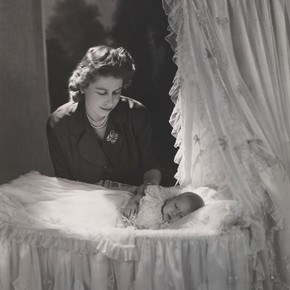
Princess Elizabeth and Prince Charles by Cecil Beaton, Gelatin silver print, December 1948, Buckingham Palace. Museum no. PH.218-1987, © Victoria and Albert Museum, London
Beaton’s tender portraits depicted the Queen as a figure to whom any parent could relate. In contrast to the splendid Coronation images, these photographs capture a more intimate and relaxed side of family life.
In the decade between the births of Princess Anne and Prince Andrew, Beaton’s approach to royal portraiture changed dramatically. All attention was now focused on the sitters, a stark white background replacing the elaborate Rococo-inspired backdrops of earlier years.
Beaton photographed Prince Charles on 13 December 1948, two days before the Prince's christening. He commissioned a new backdrop for the occasion, which his assistants installed in the gold and ivory-coloured Music Room at Buckingham Palace. Beaton used a large 8 x 10 inch and smaller Rolleiflex cameras. He recalled that, 'his mother sat by the cot and, holding his hand, watched his movements with curiosity, pride and amusement'.
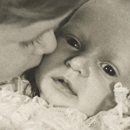
Cecil Beaton, The Next Generation - Prince Charles & Princess Anne
Prince Charles and Princess Anne
Cecil Beaton
Gelatin silver print
Clarence House
September 1950
Museum no. PH.642-1987
© Victoria and Albert Museum, LondonJust as newspaper readers had responded enthusiastically to Beaton's wartime portraits of royalty, they were moved by the intimacy of the studies of the infant royals. One reader wrote to The Sunday Graphic and Sunday News: 'Thank you for your page one picture last week - the picture of Prince Charles with his baby sister, which so many have been waiting to long to see. In my opinion, Cecil Beaton surpassed all expectation.'

Cecil Beaton, The Next Generation - Princess Elizabeth & Prince Charles
Princess Elizabeth & Prince Charles
Cecil Beaton
Gelatin silver print
Clarence House
September 1950
Museum no. PH.319-1987
© Victoria and Albert Museum, LondonPrince Charles was at the stage when he was interested in everything. A live wire, he never flagged in energy, even when those around him were exhausted. One minute he was up on a window-sill giving an unexpected treat to the passers-by below, pulling at the curtain cords; the next he was climbing onto the sofa to take the cigarettes out of a silver box; then he would be absorbed with interest in the working of his mother's snapshot camera.
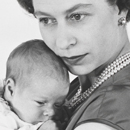
Cecil Beaton, The Next Generation - Queen Elizabeth II & Prince Andrew
Queen Elizabeth II & Prince Andrew
Cecil Beaton
Gelatin silver print
Buckingham Palace
March 1960
Museum no. PH.1806-1987
© Victoria and Albert Museum, LondonPrince Andrew Albert Christian Edward was born on 19 February 1960. He was the first child to be born to a reigning monarch since Queen Victoria. By 1960 the royal family wished to project a more accessible, modern image. Instead of the grand palace interiors, Beaton chose a simple white background for the sensitive photographs of the Queen cradling her son.
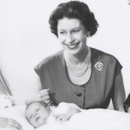
Cecil Beaton, The Next Generation - Birth of Prince Andrew
Queen Elizabeth II, Prince Philip, Prince Charles, Princess Anne & Prince Andrew
Cecil Beaton
Gelatin silver print
Buckingham Palace
March 1960
Museum no. PH.1708-1987
© Victoria and Albert Museum, LondonOn learning she was to have a third child, Queen Elizabeth wrote of her delight to her midwife, Sister Helen Rowe. She added: 'The children were very excited at the news of the baby, especially Charles, who loves small children.' In this image, the parents and children crowd around the crib to admire the new member of their family.
The 1968 sitting
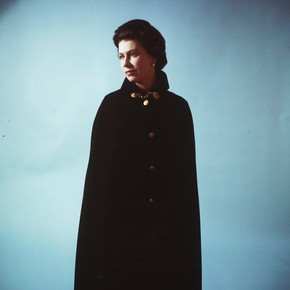
Queen Elizabeth II by Cecil Beaton, Gelatin silver print, Buckingham Palace, 1968. Museum no. PH.318-1987, © Victoria and Albert Museum, London
Beaton selected plain white and blue backgrounds, resolving to be ‘stark and clear and bold’. The portraits were a triumph. They were the last photographs Beaton made of Elizabeth II, although he continued to photograph other members of the family until 1979.
Several photographers shared with Beaton the honour of being invited to photograph Elizabeth II, yet few had such an enduring relationship with the monarchy over such a long and transformative period.
The photograph of the Queen wearing the Admiral's Boat Cloak against a blue backdrop was powerful in its simplicity. it was one of the highlights of over 500 photographs by Beaton exhibited at the National Portrait Gallery in 1968. Beaton eliminated the magnificent regalia and sparkling gowns seen in other portraits to produce a contemplative and timeless image of the monarch.
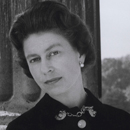
Cecil Beaton, The 1968 Sitting - Queen Elizabeth II
Queen Elizabeth II
Cecil Beaton
Gelatin silver print
Buckingham Palace
1968
Museum no. PH.1963-1987
© Victoria and Albert Museum, LondonBeaton's assistant, Geoffrey Sawyer, suggested some photographs be taken outside. Beaton noted in his diary: 'The electricians were installed with enough equipment to light an entire film unit. I gave instructions for alternative 'sets' in case the initial scene did not materialise and Geoff suggested the balcony might be good. I found a splendid Acropolis-like corner with three columns.'

Cecil Beaton, The 1968 Sitting - Queen Elizabeth II, Sovereign of the Order of the Garter
Queen Elizabeth II in the robes of Sovereign of the Order of the Garter
Cecil Beaton
Gelatin silver print
Music Room, Buckingham Palace
1968
Museum no. PH.1893-1987
© Victoria and Albert Museum, LondonThe Order of the Garter was founded by King Edward III in 1348. It is the most senior British order of chivalry. The Queen wears the robes of the Sovereign of the Order: the blue riband (or sash) and the dark blue velvet mantle, on which is pinned the Garter Star. The star comprises the St George's Cross within the Garter, surrounded by radiating silver beams. St George is the patron saint of the Order.
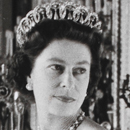
Cecil Beaton, The 1968 Sitting - Queen Elizabeth II, White Drawing Room
Queen Elizabeth II
Cecil Beaton
Gelatin silver print
White Drawing Room, Buckingham Palace
1968
Museum no. PH.1925-1987
© Victoria and Albert Museum, LondonFor photographs in the White Drawing Room, the Queen wore a turquoise silk sleeveless shift dress with silver floral embroidery designed by Hardy Amies. Daylight streamed through the windows and Beaton was elated: 'The sun was now shining for the rest of the afternoon and I bade the many assistants bring in our background from the dark cavern and rely on God's glorious daylight. Everywhere were sparkling possibilities.'
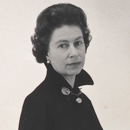
Cecil Beaton, The 1968 Sitting - Queen Elizabeth II wearing an Admiral's Boat Cloak
Queen Elizabeth II
Cecil Beaton
Gelatin silver print
Buckingham Palace
1968
Museum no. E.1370-2010
© Victoria and Albert Museum, LondonBeaton discussed plans in advance of the sitting with Martin Charteris, the Queen's Private Secretary. Charteris wrote to the Queen: 'Cecil is anxious to do something different and wondered if Your Majesty would pose for him in a simple dress or the Boat Cloak?' This contact sheet shows the Queen wearing an Admiral's Boat Cloak of dark serge fabric, slightly adjusting her pose in each shot.
Video: Queen Elizabeth II by Cecil Beaton
This film features interviews with curator Susanna Brown, Robin Muir of Vogue and a very special discussion with two of Beaton’s Coronation Day assistants, John Drysdale and Ray Harwood – together again for the first time in 60 years.
Video: Cecil Beaton's Visitors' Book
Cecil Beaton’s visitors’ book is a who’s who of the 20th century, and contained the signatures of Greta Garbo, Henri Cartier-Bresson, Dali and the Queen Mother, among many others.
Beaton’s family have kindly allowed us to take a look inside the book, and view the signatures and sketches of visiting luminaries from the 1930s up to the late 1970s.
Queen Elizabeth II by Cecil Beaton: A Diamond Jubilee Celebration was kindly sponsored by Garrard.
International Training Course
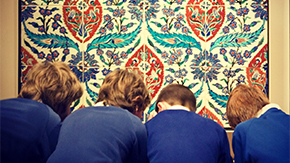
The Victoria and Albert Museum welcomes applications for ‘Creating Innovative Learning Programmes’, its new one week intensive course. This is a unique training opportunity for museum professionals from overseas who are interested in attracting and programming for a range of museum audiences.
Find out more